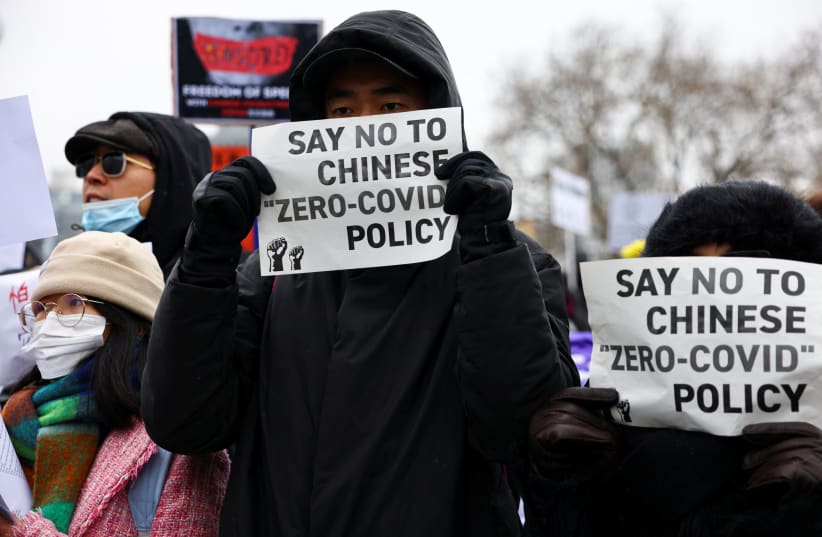Almost three years after the detection of the COVID-19 virus in the city of Wuhan, China is struggling to find a way forward. The emergence of protests exhibits the fatigue and frustration of its citizens with the so-called zero-COVID strategy, and puts the Communist Party of China (CPC) in an awkward position.
Draconian measures are still imposed to eliminate COVID-19 from the country. Frequent lockdowns with a duration of around two months, large-scale nucleic acid tests, transportation to quarantine facilities and monitoring tactics have been the main components of the CPC response to the pandemic since the beginning of 2020.
The result of such a public health doctrine has been encouraging in terms of the number of deaths. Although Chinese statistics are being suspiciously assessed in the West, the performance of the Asian giant – through the prism of mortality – is better in comparison to developed economies.
This reality has facilitated the effort of Beijing to promote its own interpretation of human rights on the international stage. The main purpose of human rights should be the protection of life, the CPC say. By extension, it can be argued that they treat their own citizens better than democracies, despite the lack of elections.
Omicron changed everything
The outbreak of the Omicron variant approximately one year ago complicated the situation. Scientists agree that this strain, in tandem with relevant sub-lineages, can dramatically increase COVID-19 cases, but with less deadly impact. Naturally, China’s determination to prevent its citizens from contracting the virus entered uncharted waters.
Notwithstanding the infection risks, the 2022 Beijing Winter Olympic and Paralympic Games were successfully organized. The conclusion of the Olympics did not mark the end of the zero-COVID policy, however. On the contrary – the CPC insisted on pursuing this policy in light of the 20th National Congress that saw President Xi Jinping win an unprecedented third term at the end of October. For ordinary citizens, life did not change even in the aftermath of the congress.
Ironically, images from the World Cup have exposed different ways of dealing with the coronavirus in the eyes of Chinese people. Full stadiums with football fans of different nationalities are in marked contrast to the restrictions and empty cities in China.
The CPC has not yet found a way to guarantee the smooth passage from the era of lockdowns, and other strict measures, to that of a safe return to relevant normality. The transition might include pitfalls. China’s health system will likely be overwhelmed if hospitalizations and admissions to intensive care units increase. Also, an expected increase in the number of deaths of older people will cause pain and sorrow in a country which values tradition and the role of family in society.
ALL THIS does not mean that adjustments in the way in which the pandemic is being dealt are not required. Recent protests are a warning signal for the CPC. More importantly, there is a silent majority of Chinese people, especially the young and the middle class, who are suffering from being housebound and living remotely since the beginning of 2020.
The history of modern China demonstrates that the CPC sometimes makes costly mistakes. It is the responsibility of President Xi Jinping to find a way to protect human life against COVID-19 without causing more discontent among citizens.
The dynamic zero-COVID policy worked, but it worked under circumstances which are no longer relevant.
Whether the CPC’s efforts to prevent the spread of new strains of the virus from the West outweighs the immediate need to solve this existing, serious problem, is an issue for the Chinese leadership to determine.
It’s not all about the pandemic itself. The last three years have seen political relations between China and the West reach a very low ebb. The lack of interpersonal relations and tourism certainly does not help.
Beijing cites trade as one factor of stability. Indeed, trade volume is increasing. For instance, in the first ten months of 2022, Israeli imports from China reached $10.8 billion from $8.7 in the same phase last year. Additionally, exports to China slightly increased to $3.7 billion from $3.5. The trend in Sino-American and Sino-European trade volumes are similar.
Of course, this encouraging economic situation cannot be taken for granted. It will not necessarily expand in the long-term as long as the image of China in the West is being continuously damaged, traveling is subject to quarantine and it becomes even more difficult for foreign citizens to stay in the country. These are all issues for the CPC to consider.
The writer is a research associate at Bar-Ilan University’s Begin-Sadat Center for Strategic Studies, a lecturer at the European Institute of Nice and a senior fellow at the Hellenic Foundation for European & Foreign Policy (ELIAMEP).

